A deep pantry can be a real lifesaver for busy homeowners. However, if it’s not organized correctly, it can quickly become a cluttered and chaotic mess. In this article, we will provide you with tips and tricks for organizing your deep pantry in a way that maximizes efficiency and makes the most of the space available. Follow these tips, and you’ll be able to find everything you need in no time!
Why Organizing a Deep Pantry is Important
A deep pantry is a food storage area that is typically deeper than it is wide. This type of pantry can be built into the wall of your kitchen or be a standalone unit. A deep pantry allows you to store more food than a traditional pantry and can be especially useful if you have a large family or entertain often.
However such an abundance of storage space can also be a bit of a challenge to keep organized. Foods can get lost in the back, expire before they are used, and generally create a cluttered mess. That’s why it’s important to take some time to learn how to organize a deep pantry.

Organizing a deep pantry can make it more functional and efficient. When your pantry is well-organized, you can easily see what food items you have and where they are located. This can help you save time when you are looking for specific items.
Finally, an organized pantry can help prevent food waste because it will be easier for you to see expiration dates and use up older items before they go bad.
Organizing a deep pantry does not have to be difficult or time-consuming. By following a few simple tips, you can create an organized space that will make your life easier. Below are some useful suggestions that will help you organize your deep pantry and make the most of the space. [1]
Useful Tips on How to Organize a Deep Pantry
So now that we know why it’s important to organize a deep pantry, let’s talk about how to actually do it.
Start with your pantry full
Don’t start removing everything from your pantry and trying to organize it all at once. This will likely lead to frustration and a bigger mess. Instead, start with a stocked pantry. When your pantry is full, you can better assess what items you need to keep and what can be donated or thrown away.
You may want to create a list of all the food items that you need to keep in your pantry so that you can easily check them off as you stock up. This includes non-perishable items like canned goods, cereals, pasta, rice, and spices as well as perishable items like fresh fruits and vegetables. This will help ensure that you do not forget anything.
Now that we’ve gone over some of the basics, let’s move on to some specific tips on how to organize a deep pantry.
Set aside items that aren’t essential
The first step in organizing your deep pantry is to set aside any items that are not essential. This includes anything that you know you won’t use as often. Next, take a look at the non-food items in your pantry such as cleaning supplies, paper products, and general household items. If there are non-food items taking up space in your pantry, such as cleaning supplies or paper goods, consider moving them to another storage area.
It’s also a good idea to set aside any duplicates that you may have. For example, if you have two can openers, four bottles of ketchup, or three rolls of paper towels, get rid of the extras. You only need one of each item so there is no reason to keep duplicates taking up space in your pantry.
Once you have sorted out all of the non-essential items from your pantry, you can start organizing what is left.
Get rid of all expired items
The crucial step in organizing your deep pantry is to get rid of all expired items. This includes any food that has gone bad as well as any cleaning supplies or other household items that are no longer usable.
To start, go through your pantry and check the expiration dates on all of your food items. If anything is expired, throw it away. Next, take a look at the non-food items in your pantry such as cleaning supplies, paper products, and general household items. If you have any of these items that are no longer usable, discard them. [1],[2],[3]
Separate other items by categories
After you have gotten rid of all expired items, the next step is to separate the remaining items into categories. This will make it easier to find what you need and put things away after you use them.

A few common categories that you may want to consider are:
- Canned goods
- Dry goods
- Spices and herbs
- Baking supplies
- Breakfast items
- Lunch and dinner items
- Fresh fruits and vegetables
You may also want to create subcategories within these larger groups. For example, you could separate your canned goods into fruits, vegetables, soups, and so on. Or you could further divide your dry goods into pasta, rice, cereal, etc. The goal is to have a system that works for you and that you can easily maintain.
Plan the designated areas ahead
It’s important to plan the designated areas in your pantry before you start grouping items together on shelves. This will help you to know where everything should go and will make the organizing process much easier.
Start by deciding what items you want to keep in your pantry.
For example, one area could be for non-perishable food items such as canned goods, cereals, pasta, rice, and spices. Another area could be for perishable items such as fresh fruits and vegetables. You may also want to create a designated area for cleaning supplies or paper products. [1],[2],[3],[4]
Place non-essential items in the back
Once you have designated areas for all of the items in your pantry, it’s time to start placing things on the shelves. Start with the non-essential items and place them in the back. This includes any duplicates that you may have as well as any items that you rarely use.
By putting these items in the back, they will be out of the way and won’t get in your way when you are looking for something else. You can also put smaller appliances on higher or lower shelves so that they are even less likely to be in your way.
Keep extra items in the back
Don’t just throw away any duplicates or extra items that you have in your pantry. These can be useful to have on hand in case you run out of something or if you need them for a special occasion.

Instead, keep them in the back of your pantry so that they are out of the way but still accessible when you need them. This includes things like extra spices, canned goods, pasta, rice, and cereal. By keeping these items in the back of your pantry, they will be out of sight but still within reach. [2]
Make sure items that you use frequently are easy to reach
After you have placed all of the non-essential items in the back, it’s time to focus on the items that you use more frequently. These items should be placed in an easily accessible location so that you can get to them quickly when you need them.
For example, if you use canned goods often, you may want to keep them at eye level or within easy reach. Or if you use spices frequently, you may want to keep them in a drawer near your stove. By keeping the items that you use often within easy reach, you will save yourself time and frustration. [1],[2]
Place items in height order
Once you have placed all of the items by their category,, it’s time to start organizing them by height. This will help you to maximize the space in your pantry and make it easier to find what you need.
For example, you can place taller items farther back on the shelves and shorter items in front. Or you can group items of similar heights together. By organizing your pantry in this way, you will be able to make the most of the space that you have. This way smaller items will not get lost in the back and taller items will not block your view of what’s behind them.
Reserve deeper shelves for appliances and bulkier items
The deeper shelves in your pantry can be reserved for appliances and bulkier items. This includes things like the coffee maker, toaster, blender, and food processor. These items can be difficult to store in a shallow pantry so it’s important to make use of the deeper shelves.
You may also want to keep larger or bulkier items on these shelves such as cases of jars or large bags of flour. By reserving the deeper shelves for these types of items, you will be able to make better use of the space in your pantry.
Place heavier items on lower shelves
When you are organizing your pantry, it’s important to keep the weight of the items in mind. Heavier items, like flour bags should be placed on lower shelves so that they don’t fall and make a mess.
For example, canned goods and jars of sauce can be quite heavy so they should be stored on lower shelves. By placing heavier items on lower shelves, you will be able to keep your pantry organized and safe. [4]
Keep snacks and sweets high up
If you have kids, you may want to keep snacks and sweets high up out of their reach. This includes things like candy, cookies, and chips. By keeping these items high up, you will be able to prevent kids from getting into them on their own. [1]
Position items based on their Best Before date
Check the expiry dates on all of your pantry items and position them accordingly. For example, items that are expiring soon should be placed in an easily accessible location so that you can use them before they go bad. By placing these items in the front, you will be less likely to forget about them and let them expire.

On the other hand, items with a longer shelf life can be stored farther in the pantry but within the same general area. This way, you can still keep track of them and use them before they expire.
By positioning items based on their expiry date, you will be able to keep your pantry organized and prevent food waste. [4]
Use baskets or bins
One of the best ways to organize a deep pantry is to use baskets or containers. This will help keep everything neat and tidy and prevent small items from getting lost in the back of the pantry.
You can use baskets and bins to store everything from canned goods to dry goods such as pasta, rice, and cereal. You can also use them to store smaller items such as spices, baking supplies, and condiments.
You don’t want something that is too big or too small.
You can find baskets and containers at your local dollar store, home improvement store, or online. Or, you can make some yourself out of both recycled and natural materials.
It’s also a nice idea to find baskets that match or complement the décor of your kitchen. This will give your pantry a more pulled-together look.
What to consider when choosing a container for your pantry
There are actually a few more things to consider when choosing a container for your pantry.
Transparency of containers
One of the most important factors to keep in mind is the transparency of the containers. You want to be able to see what’s inside so that you can easily find what you’re looking for. Clear storage containers make it easy to see what food items you have and where they are located.
Flour and grains, for example, are best stored in air airtight, clear canisters. Not only will this keep them fresh and safe from pests, but you’ll also be able to see what you have at a glance and how much is left.

For spices, look for small glass jars with airtight lids. This will allow you to see the contents as well as keep them fresh for longer.
This means that clear or semi-transparent containers are best. That way, you can quickly scan the contents and find what you need without having to open each one. If you prefer a more streamlined look however, then transparent containers may not be the best option for you. In this case, it might be better to use opaque containers or baskets. [1],[2],[3],[4]
Stackability of containers
You also want to make sure that the containers you choose are stackable. This will help you maximize the space in your pantry even further. Stackable containers come in a variety of materials, shapes, and sizes.
When stacking containers, it’s important to make sure that they are stable and won’t topple over. You don’t want to have to reach into a precarious stack of containers every time you need something from the pantry.
A good way to test the stability of a stack is to push on it from different angles. If it wobbles or feels like it might fall over, then it’s probably not safe to stack.
Another thing to consider is the weight of the items you’ll be putting in the containers. If you’re going to be storing heavy items, then you’ll need to make sure that the containers are sturdy enough to support the weight.
Functionality of containers
Finally, you want to make sure that the containers you choose are functional. This means that they should be easy to open and close and that they seal well.
You don’t want to have to struggle to open a container every time you need something from the pantry. And you definitely don’t want your food items spilling out all over the place.
Make sure to test the lids of the containers before you buy them. They should fit snugly and be easy to remove. You should also check for leaks by filling the container with water and seeing if any liquid escapes. [3]
Label your containers properly
If you are using baskets or bins to organize your pantry, make sure to label them properly. This will help you know what goes where and make it easier to find what you need.
It’s best to avoid simple, general labels and instead go with something more specific. For example, instead of labeling a container “spices”, you could label it “cumin” or “paprika”.
You can use a simple label maker or just write the labels by hand. But, make sure they are legible so that you can easily read them.
It’s a good idea to mark the expiry date of some items on the label as well. This way, you can easily see when they need to be used up. [5]
Don’t store incompatible items next to each other
When you are organizing your pantry, it is important to keep in mind that not all food items can be stored next to each other. For example, bananas are known to be ethylene producers, which means that they can speed up the ripening process of other fruits and vegetables and make them spoil faster. This means, if you would place bananas and lettuce next to each other, the lettuce will most likely wilt and spoil much faster.

So when you are organizing your pantry, make sure to keep these incompatible items separate from each other. This will help extend the shelf life of your food and prevent certain items from absorbing the smells of others. [5],[6]
Add drawers
Drawers are a great way to organize a pantry because they help you keep everything tidy and in its place. If you want to add drawers to your pantry, make sure to measure the space first and then buy drawer units that fit snugly.
You can use drawer dividers to create compartments for different items. This will help you keep things organized and easy to find. And, it will also prevent items from rolling around and getting lost in the back of the drawer.
One of the ways to utilize drawers is to use them for storing vegetables or fruits that need to be kept cool and out of the light. This way, they will stay fresh for longer. [1],[4]
Use shelves on pantry doors
If you have space on the inside of your pantry door, make use of it by installing hanging shelves. This is a great way to store items that you use often, such as spices, oils, and condiments. Plus, it frees up valuable shelf space for other items.
Mesh baskets are a popular option for hanging shelves because they allow you to see what is inside each basket and easily grab what you need.
Another option is to hang hooks on the door and use them for storing things like pots and pans or aprons. This will free up some space in your cabinets and make it easier to find what you need when you’re cooking. [1],[3]
Make sure the pantry is easy to clean
It’s also a good idea to line the shelves with shelf liner. This will help prevent spills from making a mess and will make it easier to clean up any spills that do happen.
Finally, make sure to regularly wipe down the shelves and vacuum the floor to keep the pantry clean and free of dust and dirt.
Don’t slack on placing items properly after you’re done
Finally, once you have finished organizing your pantry, you will have to keep it up by always putting things you buy in the designated place. This is the only way to maintain an organized pantry and make sure it doesn’t become a mess again. [3],[5]
Comparison of Deep Pantry Organizing Indicators
A well-organized pantry can help you save time and money while ensuring that you have the necessary ingredients to make meals. A deep pantry, with shelves that extend back farther than traditional pantry shelves, can hold a large quantity of food and supplies, but it can also become disorganized quickly. In this table, we compare various indicators to help you organize your deep pantry effectively.
| Indicator | Definition | Ideal Range |
|---|---|---|
| Expiration Date Tracking | The ability to track expiration dates of food items in the pantry. | Consistently up-to-date and accurate |
| Grouping of Items | The practice of grouping similar items together in the pantry. | Group items by category or use (e.g., baking supplies, canned goods, snacks). |
| Inventory Management | The process of tracking pantry inventory and restocking as necessary. | Regularly update inventory and restock as needed. |
| Labeling System | The use of labels to identify the contents of containers and their expiration dates. | Clear and easy-to-read labels on all containers. |
| Shelf Optimization | The practice of optimizing shelf space by adjusting shelf height and using shelf dividers. | Maximize available space while ensuring items are easily accessible. |
The table compares five indicators for organizing a deep pantry. These indicators include expiration date tracking, grouping of items, inventory management, labeling system, and shelf optimization. For each indicator, the definition, ideal range, and a brief description are provided. By using these indicators as a guide, you can effectively organize your deep pantry and ensure that you always have the necessary ingredients and supplies on hand.
Read more guides to upgrade your home:
- How to Hang Tapestry on Ceiling?
- How to Remove a Pocket Door?
- How to Fix Steep Stairs Little Headroom?
FAQ
How do you organize a deep corner of the pantry?
The best way to organize a deep corner of your pantry, is to use a useful tool called lazy susan. This is a round, rotating platform that you can use to store items in the back of your pantry. Lazy susans come in all different sizes, so you can find one that fits perfectly in your space.
How do you style deep shelves?
There are a few ways to style deep shelves, depending on your aesthetic preferences. You can go for a more traditional look and line the shelves with canisters or jars filled with staples like flour, sugar, and rice. Or, you can get creative and use baskets or bins to store items like potatoes, onions, and other root vegetables. If you have the space, you could even install some hooks on the sides of the shelves to hang pans or pots. No matter what route you choose, just be sure to label everything so you know where everything is!
Useful Video: How to Organize Deep Pantry Shelves?
Conclusion
So there you have it – a guide to organizing your deep pantry. It might seem daunting at first, but once you get started, you’ll be amazed at how much easier it is than you thought. And the best part is that by taking the time to organize your pantry, you’ll make it more functional and maximize the space available to you.
Splitting items into categories and labeling your containers alone can make your life a lot easier. It’s time-consuming to find what you need when everything is just shoved in a drawer or cabinet. With a little bit of effort, you can create an organizational system that works for you and makes getting dinner on the table a breeze. Thanks for reading!
References:
- https://practicalperfectionut.com/organize-a-deep-pantry/
- https://amandakatherine.com/blog/how-to-organize-a-pantry/
- https://www.hgtv.com/lifestyle/clean-and-organize/how-to-organize-kitchen-pantry
- https://www.homesandgardens.com/kitchens/how-to-organize-deep-pantry-shelves
- https://www.organized-home.com/posts/organizing-pantry-tips-secrets-mistakes/
- https://morningchores.com/produce-that-cant-be-stored-together/










Leave a Reply